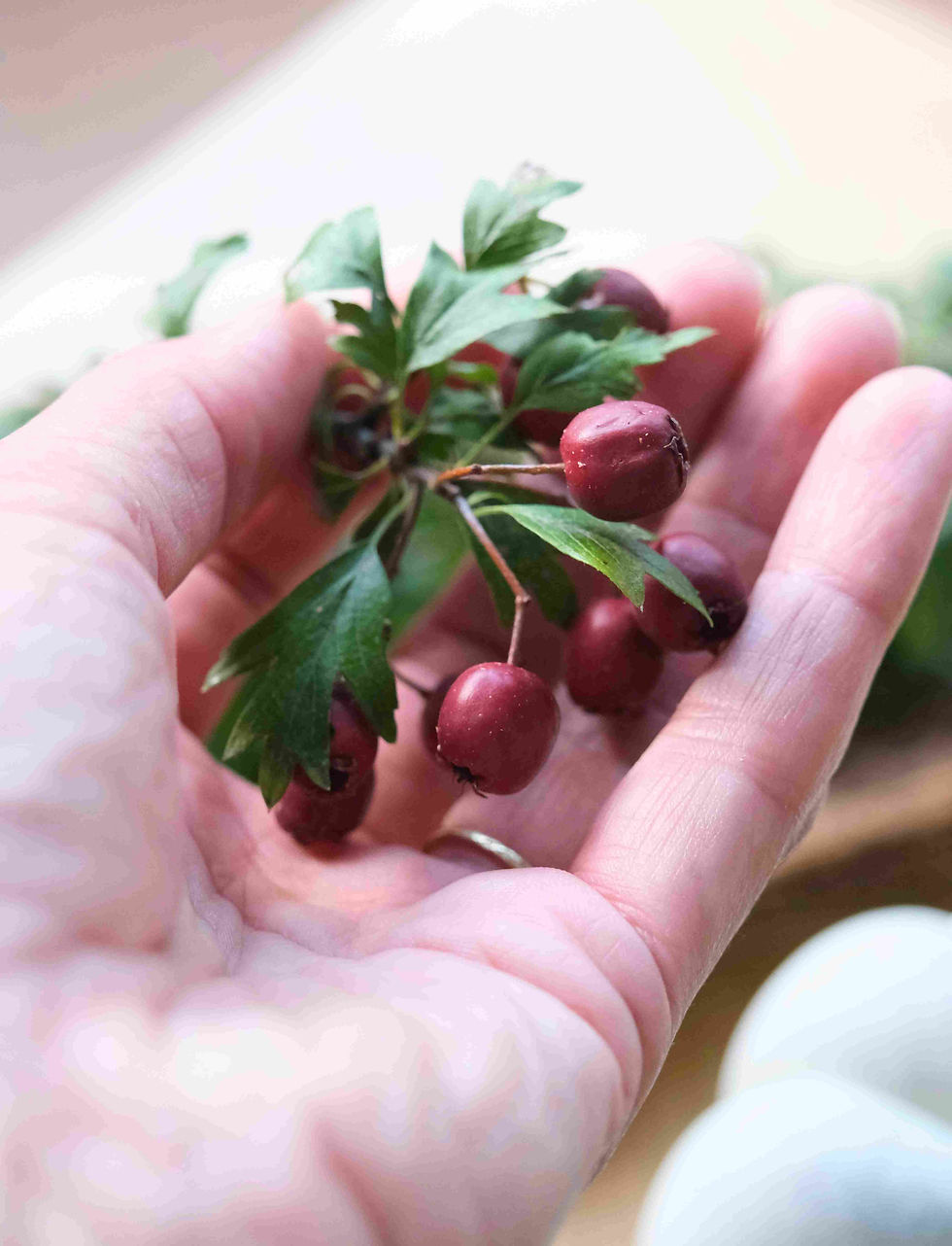Hawthorn Uses and Benefits: From Heart Health to Stress Relief
- Astrid van Essen
- Sep 27
- 4 min read
Cycling through Amsterdam, I often notice hedgerows dotted with red berries in autumn. At first, I thought they were just another pretty tree brightening up the season. But then I learned they were hawthorn, a plant with a long reputation as the “heart herb.” The more I read, the more I realised why herbalists across Europe and beyond have cherished it for centuries.
In this post, "The Benefits of Hawthorn", I’ll share what makes hawthorn so special, how it can support wellbeing, and simple ways you can use it at home.
What Is Hawthorn?
Hawthorn (Crataegus monogyna and related species) is a small, thorny tree or shrub that grows widely across Europe, Asia, and North America.

You might recognise it by:
Spring blossoms: fragrant white (sometimes pinkish) flowers in May — hence its nickname “May blossom.”
Autumn berries: small, bright red fruits known as “haws.”
Sharp thorns: along its branches, making it a natural protective hedge.
It’s not just ornamental — hawthorn has been used for centuries in both traditional European herbalism and Chinese medicine.
This article first appeared on my sister website, Simmer & Stir, where I share seasonal recipes, herbal guides, and natural home apothecary ideas. I wanted to bring it here too, as hawthorn isn’t just a traditional “heart herb” — it’s also a supportive plant for women’s wellness, especially during midlife.
Traditional and Modern Benefits of Hawthorn
1. Heart Health
Hawthorn is most famous for supporting the cardiovascular system. Herbalists often call it a tonic for the heart because it can:
Improve circulation.
Support healthy blood pressure.
Strengthen the heart muscle.
Modern studies have investigated the use of hawthorn extract for treating mild heart failure, arrhythmias, and improving overall cardiovascular health. While research continues, its reputation as a gentle yet effective “heart herb” is well established.
2. Calming and Stress Relief
Hawthorn has a mild calming effect, often recommended to ease nervous tension, anxiety, or restlessness. A cup of hawthorn tea in the evening can be a soothing ritual, helping both body and mind unwind.
3. Digestive Support
Traditionally, hawthorn was taken after heavy meals to aid digestion. The berries and leaves are thought to stimulate the digestive process and reduce bloating.
4. Antioxidant Boost
Packed with flavonoids, proanthocyanidins, and vitamin C, hawthorn offers antioxidant support. These compounds help protect the body from oxidative stress, contributing to overall vitality and immune support.
How to Use Hawthorn at Home
You can enjoy hawthorn in several simple ways:
Hawthorn Tea
Use dried berries, flowers, or leaves.
Steep 1–2 teaspoons in hot water for 10–15 minutes.
A warming herbal tea with a slightly tart flavour.
Tincture
Alcohol-based extracts are available in health shops.
Often taken in small doses to support circulation.
Capsules and Supplements
Convenient, standardised forms exist but should be used mindfully, especially if you’re already on medication.
Seasonal Blends
Spring: Use blossoms in calming teas.
Autumn: use berries in syrups, tonics, or even simmer pot blends (combined with cinnamon, clove, and orange peel).
Safety and Precautions
Hawthorn is generally considered safe, but there are a few notes of caution:
It may interact with certain heart medications (such as digoxin or beta-blockers).
If you have a heart condition or take prescription medication, always consult a GP or qualified herbalist before use.
Maintain moderate dosages and avoid excessive intake.
Hawthorn Uses and Benefits: Closing Thoughts
Since I’ve started noticing hawthorn in the hedgerows around Amsterdam, I see it everywhere — a reminder that powerful, healing plants often grow right under our noses. For me, hawthorn is more than a heart tonic; it’s a symbol of resilience, protection, and the quiet strength of nature.
If you’re curious about actually gathering hawthorn berries yourself and turning them into syrups, teas, or simmer pots, I’ve written a full guide here: [Foraging Hawthorn Berries: What to Look For and How to Use Them].
Frequently Asked Questions About Hawthorn
1: Can I eat hawthorn berries raw?
Yes, hawthorn berries are edible, though they have a mealy texture and mild taste. Most people prefer them cooked into jelly, syrup, or tea rather than eating them straight from the tree.
2: What is hawthorn most commonly used for?
Traditionally, hawthorn is known as a “heart herb.” It’s often used to support circulation, balance blood pressure, and calm stress. You’ll also find it in teas and tinctures for overall well-being.
3: Is hawthorn safe to take every day?
For most people, hawthorn tea or small amounts of tincture are safe for daily use. However, if you are on heart medication or have a heart condition, it’s important to check with your doctor before taking it regularly.
4: Which part of hawthorn can I use — flowers, leaves, or berries?
All three are used in herbalism.
Flowers and leaves are often dried for tea.
Berries are commonly used for syrups, jelly, and tinctures.
5: When is the best time to pick hawthorn?
Blossoms are usually gathered in May.
Berries (haws) are best picked in autumn, from September to November.
6: Does hawthorn really help with anxiety?
Yes, hawthorn has gentle calming properties. Herbalists often recommend it as a supportive tea to reduce stress, soothe nervous tension, and encourage relaxation.




Comments